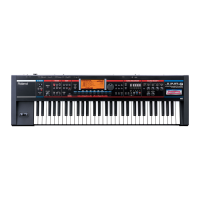Working with e!ects
Processing an external signal
With the Juno-G it’s possible to process sound from an external source
(microphone, audio player, guitar or another synthesizer) using it’s internal
eects processors. This can be used both during recording and for realtime
applications.
To send the external audio into one or more eects processors:
1. Connect the external source to the Juno-G’s input jacks.
2. Set the AUDIO IN mixer slider to the lowest position.
3. In the main PATCH or PERFORMANCE screen, press MENU, choose
Input Setting and press ENTER.
4. Set the Input Select parameter to the value which correspond to
what and how you have connected:
•
LINE IN L/R: stereo line input (L and R jacks)
•
LINE IN L: mono line input (L jack)
•
MICROPHONE: microphone input (L jack)
5. Play something using the external sound source (instrument) and
use the AUDIO IN slider to set a normal signal level.
6. On the screen, the Audio Input Assign parameter denes where the
external signal goes:
•
MFX 1, 2 or 3: will be processed using the respective MFX unit
•
DRY: will not go into the MFX
8

